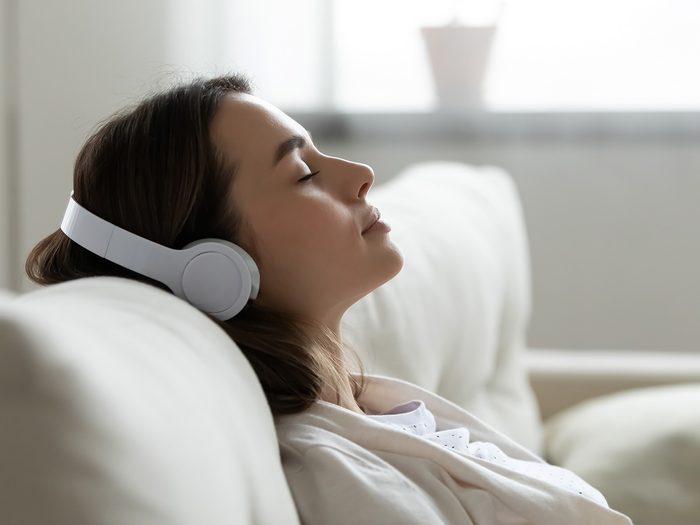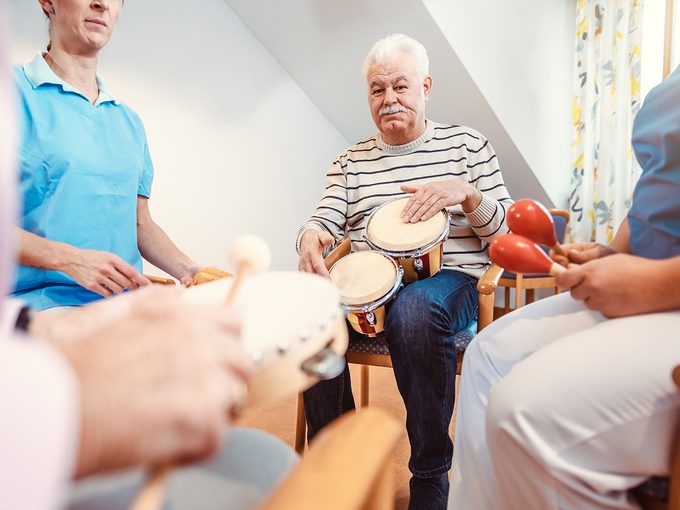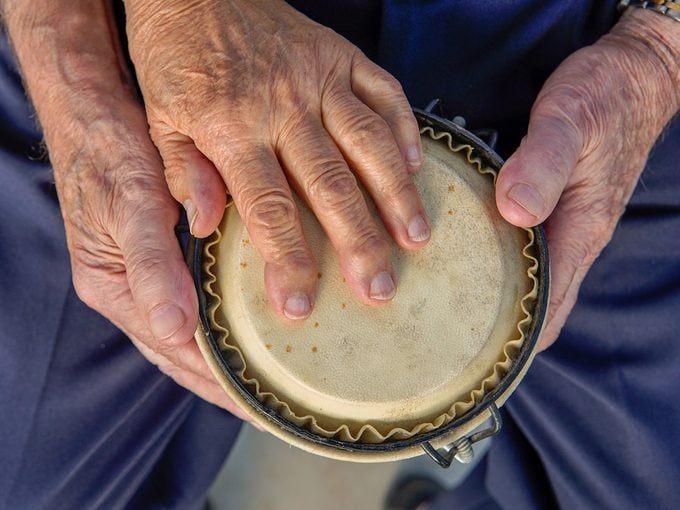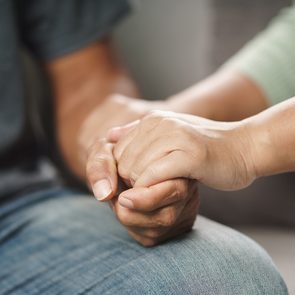How Music Therapy is Changing People’s Lives

From boosting the immune system to reducing stress, the benefits of music therapy are being embraced by modern medicine.
There’s one patient that SarahRose Black still thinks about. Back in 2019, the nursing team in the palliative care unit at Toronto’s Princess Margaret Cancer Centre asked if she could reach out to a patient who had been there for about a week. The man was struggling, and unwilling to engage with staff or be part of any activities. “They told me, ‘He’s short and grumpy with us, and we wonder if you might have an in.’”
Black isn’t a doctor or a nurse. Since 2013 she has played an important role for patients as Princess Margaret’s on-staff music therapist. On any given day, she might see one person who’s anxious about an upcoming procedure, another who’s undergoing chemo and in need of a soothing moment. Or, like the man in the palliative care unit, it might be someone who doesn’t yet know they need her.
So, on a wintery Wednesday afternoon, Black approached the patient’s room and introduced herself. She asked if she could sit, and offered to play some music. In an effort to convince him, she said, “If you don’t like it, you can tell me to leave,’” she recalls.
After some gentle urging, the 70-something man, who had lung cancer, told her a few classical composers he liked and then turned away to look out the window. But as she started to play one of his favourites, Bach, on her portable keyboard, a change came over him. He unfolded his arms, turned toward Black and started to cry.
She stopped playing. “Do you want me to continue?” she asked.
“Absolutely,” he said through tears.
“It was as if the music went places that nothing else could,” recalls Black. “He shared with me afterward that he’d been holding in so much and had been unable to talk about anything—but the music showed up at a moment when it felt like a hug.”
Anyone who has felt that spark of joy when a favourite song comes on the radio at just the right moment—or wept along with a singer who is expressing heartache—will understand the emotional resonance of music. But now, a growing body of scientific evidence is actually demonstrating that music can be medicine, too. Read on to discover the many health benefits of music therapy.

The benefits of music therapy
In a review of 400 research papers looking into the neurochemistry of music, Daniel Levitin, a psychologist and neuroscientist at McGill University in Montreal, found that playing and listening to music had clear mental and physical health benefits, including improving our immune systems and reducing stress levels.
One 2007 study from a team of Spanish researchers found that listening to music before surgery had the same effect in reducing preoperative anxiety as taking Valium—an important finding, as anxiety before a major surgery can affect post-operative pain and recovery time. Another Spanish study, conducted in 2018 in the palliative care unit of Barcelona’s Hospital del Mar, found that patients participating in a music-therapy program experienced significant decreases in tiredness, anxiety and breathing difficulties, as well as an increase in feelings of well-being.
Even major health-care institutions are embracing music therapy on a wide scale. In 2019, the National Institutes of Health in the U.S. introduced significant funding—$20 million—to support research projects in music therapy and neuroscience.
A music-therapy session can be as unique as an individual patient’s needs on a given day. With Black, who also sings, that inevitably involves the cart of instruments she travels with (“I’m pretty much a one-woman band,” she jokes). Aside from the keyboard, to create rhythms and texture she has other instruments such as a guitar, tambourine, singing bowls and more. She also brings recording equipment and an iPad, to supply song lyrics.
If a patient loves classical music, she’ll play it. Maybe it’s folk or jazz. She did a Bob Marley tune for a man’s assisted-dying process. “One woman spoke no English, but she taught me a Farsi folk song, and we had this wonderful exchange,” says Black. “She’d sing a line, I’d sing it back, and we were singing this beautiful song together.”
She’s gentle in her approach with patients. “I make it very clear that preexisting musical experience or training isn’t required to participate,” she says. “If I were to ask, ‘What kind of music do you like?’ that might be a difficult question to answer. Instead I ask what they want to feel, which is an easier question to answer.”
If the goal is pain management, Black might match the pace of her playing with the patient’s breathing, and then gradually slow the music. This process, called “entrainment,” can help slow the breath, too, and has a calming effect.
Or a session might be about helping a patient process the emotions stemming from what they are going through. It may even be about connecting with loved ones who are in the room with them. “Sometimes the patient says, ‘I’m having such a profound experience. I have no words,’” she says. “We know from so many wonderful brain studies that music can trigger memories and touch parts of the brain that other mediums cannot.”
Here are 10 mental health podcasts worth adding to your playlist.

Music therapy programs
Once a week Carol Cameron hops on Zoom from her home in Madison, Wisconsin. She’ll be joined by a dozen or so other participants, all following along as music therapist Jason Armstrong Baker leads them through drumming exercises—sometimes clapping their hands in a distinct rhythm he’s laid out for them, sometimes tapping on their own bodies.
Like everyone taking part in the session, Cameron, 71, has Parkinson’s disease, and this drumming circle—known as Rx 4 Rhythm—is designed to help strengthen her coordination. “My tremor is on my left side, so learning things with my left hand is difficult,” she says. “But it’s really good to get this regular rhythm going—it gives you a feeling of overcoming a problem.”
Rx 4 Rhythm is just one of the programs offered at the Johns Hopkins Center for Music and Medicine in Baltimore. The research institution is the brainchild of Dr. Alexander Pantelyat, a violin player and former member of the Penn Symphony Orchestra in Philadelphia. Today, he is a neurologist who specializes in movement disorders like Parkinson’s and Huntington’s. The centre provides music therapy and more, Pantelyat explains. They’re taking music into the “precision medicine” realm.
Applying that kind of treatment to movement disorders is relatively new; previously, it was mainly the domain of cancer therapies. “There’s a revolution in oncology and cancer research—more people are being cured, and much of it can be attributed to a very targeted precision treatment that really is individualized for the patients,” he explains. “Just listening to music activates many regions of the brain simultaneously.”
He adds that there is an understanding in the field of music medicine that there can be tailored interventions using music that a person actually likes, that speaks to them culturally, personally, autobiographically.
One study from the Center for Music and Medicine followed a choir composed of Parkinson’s patients (called the “Parkinsonics”) to learn how singing might impact the speaking voice of those patients. After 12 weeks, the singers’ speaking volumes—which often fade as Parkinson’s progresses—grew demonstrably stronger. The Rx 4 Rhythm drumming circle, meanwhile, came out of a 2015 study that showed that Parkinson’s patients had improved their ability to walk after six weeks of drumming practice.
The centre’s blueprint is to continue to fund these musically oriented groups, even after the studies have wrapped up. “Patients in the Parkinsonics told us that they didn’t want to stop singing when the study was over,” says Pantelyat. The centre now funds a professional choir instructor, a music therapist and a social worker to help the choir members carry on with their classes, which rolled onto Zoom during the pandemic.
And while sessions at the centre do have therapeutic goals—working on coordination, say, or breathing techniques for anxiety management—there’s a community-building element to the groups, too. Kerry Devlin is the centre’s senior music therapist and runs an online support group for people with a broad range of neurological disorders, along with their care partners—those people in patients’ lives, usually loved ones, who are supporting them through their illness.
“There can be folks who are experiencing really intensive symptoms, like a decline in their ability to verbally communicate,” says Devlin. Music, she notes, can sometimes help such patients find ways to respond again.“I’ve had the honour of making music with people, and all of a sudden they’re coming up with new words. It turns into this beautiful improvisational moment—and a care partner is saying, ‘I’ve never seen this happen.’”
It’s a powerful thing, she says, to witness someone find themselves again for a moment, and when a song is the vehicle for that shift.
Much of what Devlin does is designed to help patients feel like more than just cogs in the medical system. “Of course they want to come and receive medications and treatments, but they’re also a person,” she says. “It’s important when we’re thinking about holistic care to provide opportunities for patients to actually process the impact that a diagnosis is having on their lives.”

Music therapy for kids
Music can have a profound effect on helping sick children, too. Ruth Hunston is a music therapist in the “play department” at the Great Ormond Street Hospital in London, England. As the U.K.’s oldest children’s hospital, it sees more than 69,000 patients a year.
“When children are in the hospital, their worlds get much smaller,” says Hunston, who explains that her program, introduced in 2019, helps give young patients back some sense of control. “They’re having so many things done to them and around them, but this allows them to create something themselves.”
Extended time in pediatric care can also affect a child’s development, says Hunston. In light of that, much of her program is designed to help them progress. “I’ve had lots of infants who have sat up for the first time at the drums, because they’re just so motivated to play,” she says. “Or they start making sounds because I’m singing to them, and they want more.”
The parents also become part of the therapeutic process. “It’s not easy being in a hospital, and it’s not easy to leave your child there,” she says. “What’s really lovely is when you go in and you start to make music, and the children invite their parents to join. There’s this beautiful interaction between everyone, and sometimes I get to step back and just watch them play—to really laugh and have fun.”
Palliative care
At the Dr. Bob Kemp Hospice in Hamilton, Ontario, music therapy has become an integral part of patient care in residential end-of-life settings. “The palliative journey isn’t really about someone dying,” says Doug Mattina, director of the hospice’s pediatric unit. “It’s about bringing the most joy. It’s providing the wrap-around care not only for the individual but for those impacted by it.”
Mattina himself experienced the music-therapy program when his father spent his last days at the hospice. “I remember when the music therapist said to him, ‘Bill, what kind of mood are we in today?’ And he said, ‘Today is time to dance,’” says Mattina.
He was so moved by the whole experience that he left a career in the foreign service to work full-time for the hospice. “Even though my father was feeling like crap, and we knew that we had days or hours left, me, my sister, my brother and my mom would dance around his bed. His favourite song for this was ‘Rasputin,’ and he would request high kicks from us as he clapped along. Sometimes he’d fall asleep as we danced.”
Sara Klinck directs the music-therapy program at the hospice, where, at a patient’s bedside, she might improvise a call-and-response song to help them open up about how they’re feeling that day, or help a resident write a song as a legacy for their family.
“We might also revisit songs that have personal significance for residents and families, as a way to communicate emotion to one another,” she says. “It can feel like a whole choir as visitors and family members join in. For some people, sometimes what’s hard to say is easier to sing.”
It could also mean fulfilling a lifelong goal before a patient passes away, as she did for someone with late-stage ALS. “He had very limited movement in his hands but had always wanted to play guitar,” says Klinck.
She brought in the instrument and laid it on his lap in bed. “He was able to put his hands on the strings and interact with them; often I moved the guitar, as well.” This music experience was something his family felt would be very meaningful to him.
Finding those moments is the skilled therapist’s role, but as SarahRose Black notes, people have been connecting with music for their whole lives—she is just helping them access it again at a time when they need it most.
“We have a heartbeat, so we have a drum inside us; we are wired to be musical people,” she says. She smiles softly as she reflects back on one patient, a man in his late 30s with late stage brain cancer.
“He said, ‘SarahRose, I have a lot of friends, and they’re great. They show up and they’re helpful, but they don’t really understand what’s going on here,’” she says. “He told me that the music is like a friend who ‘gets it.’”
Now that you’re familiar with the benefits of music therapy, find out how cold-water therapy could boost your health.







